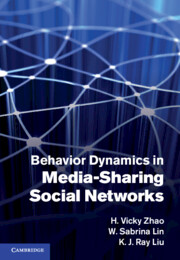Book contents
- Frontmatter
- Contents
- Preface
- Part I Introduction
- Part II Behavior forensics in media-sharing social networks
- Part III Fairness and cooperation stimulation
- Part IV Misbehaving user identification
- Part V Media-sharing social network structures
- 13 Misbehavior detection in colluder social networks with different structures
- 14 Structuring cooperation for hybrid peer-to-peer streaming
- References
- Index
14 - Structuring cooperation for hybrid peer-to-peer streaming
from Part V - Media-sharing social network structures
Published online by Cambridge University Press: 28 April 2011
- Frontmatter
- Contents
- Preface
- Part I Introduction
- Part II Behavior forensics in media-sharing social networks
- Part III Fairness and cooperation stimulation
- Part IV Misbehaving user identification
- Part V Media-sharing social network structures
- 13 Misbehavior detection in colluder social networks with different structures
- 14 Structuring cooperation for hybrid peer-to-peer streaming
- References
- Index
Summary
In the previous chapter, using colluder social networks in multimedia fingerprinting as an example, we showed that the network structure can affect misbehavior detection and and the overall system performance. In this chapter, we investigate the impact of network structure on the optimal cooperation strategies in hybrid P2P streaming networks, in which some users with very high interconnection bandwidth act jointly as one user to interact with the rest of the peers.
Although P2P video streaming systems have achieved promising results, they also introduce a large number of unnecessary traverse links, which consequently leads to substantial network inefficiency. However, in reality, every peer can have a large number of geographically neighboring peers with large intragroup upload and download bandwidth, such as peers in the same lab, building, or campus. If these peers have special collaboration among themselves and work jointly as one user toward the rest of the network, the unnecessary traverse links can be reduced. In this chapter, we denote those geographically neighboring peers with large intragroup upload and download bandwidths as group peers. To reduce the unnecessary traverse links and improve network efficiency, instead of considering each peer's strategy independently, we investigate possible cooperation among group peers and study their optimal collaboration strategy.
Because of the heterogeneous network structures, different group peers might take different roles during cooperation. In this chapter, we investigate the optimal cooperation strategies under different compositions of group peers, including the scenarios with or without central authorities, and examine whether peers can have different amounts of resources.
- Type
- Chapter
- Information
- Behavior Dynamics in Media-Sharing Social Networks , pp. 308 - 325Publisher: Cambridge University PressPrint publication year: 2011



